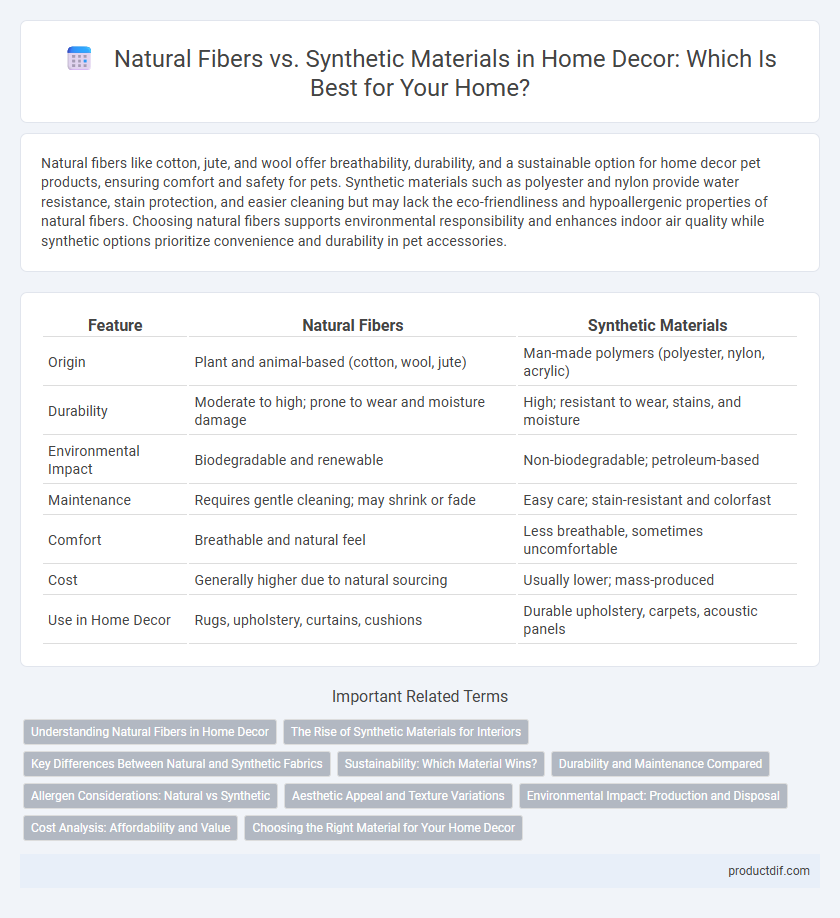Natural fibers like cotton, jute, and wool offer breathability, durability, and a sustainable option for home decor pet products, ensuring comfort and safety for pets. Synthetic materials such as polyester and nylon provide water resistance, stain protection, and easier cleaning but may lack the eco-friendliness and hypoallergenic properties of natural fibers. Choosing natural fibers supports environmental responsibility and enhances indoor air quality while synthetic options prioritize convenience and durability in pet accessories.
Table of Comparison
| Feature | Natural Fibers | Synthetic Materials |
|---|---|---|
| Origin | Plant and animal-based (cotton, wool, jute) | Man-made polymers (polyester, nylon, acrylic) |
| Durability | Moderate to high; prone to wear and moisture damage | High; resistant to wear, stains, and moisture |
| Environmental Impact | Biodegradable and renewable | Non-biodegradable; petroleum-based |
| Maintenance | Requires gentle cleaning; may shrink or fade | Easy care; stain-resistant and colorfast |
| Comfort | Breathable and natural feel | Less breathable, sometimes uncomfortable |
| Cost | Generally higher due to natural sourcing | Usually lower; mass-produced |
| Use in Home Decor | Rugs, upholstery, curtains, cushions | Durable upholstery, carpets, acoustic panels |
Understanding Natural Fibers in Home Decor
Natural fibers such as cotton, jute, wool, and linen offer superior breathability, sustainability, and a unique texture that enhances home decor's organic aesthetic. These fibers are biodegradable and hypoallergenic, making them ideal for eco-conscious homes seeking both comfort and environmental responsibility. Incorporating natural fibers in rugs, upholstery, and curtains adds warmth and durability while promoting healthier indoor air quality.
The Rise of Synthetic Materials for Interiors
Synthetic materials have surged in popularity for home interiors due to their durability, affordability, and wide range of textures that mimic natural fibers. Innovations in polyester, acrylic, and nylon enable designers to create stylish, stain-resistant upholstery and drapery that withstand everyday wear and tear. This shift towards synthetic options reflects a growing demand for practical, low-maintenance home decor solutions without sacrificing aesthetic appeal.
Key Differences Between Natural and Synthetic Fabrics
Natural fibers, such as cotton, wool, and jute, offer breathability, biodegradability, and a softer texture, making them ideal for eco-friendly home decor. Synthetic materials like polyester, nylon, and acrylic provide enhanced durability, stain resistance, and affordability, but often lack environmental sustainability. The key differences lie in their environmental impact, moisture-wicking abilities, and longevity, influencing choices between comfort and maintenance in interior design.
Sustainability: Which Material Wins?
Natural fibers like cotton, jute, and wool offer superior sustainability due to their biodegradability and lower environmental impact during production compared to synthetic materials such as polyester and nylon. Synthetic fibers, derived from petrochemicals, contribute significantly to pollution and rely on non-renewable resources, often shedding microplastics into ecosystems. Prioritizing natural fibers in home decor enhances eco-friendly practices by promoting renewable resource use, reducing carbon footprint, and supporting circular economy principles.
Durability and Maintenance Compared
Natural fibers such as cotton, wool, and jute offer breathable, eco-friendly home decor options but generally require more delicate care and have lower durability compared to synthetic materials. Synthetic fibers like polyester, nylon, and acrylic are highly durable, resistant to stains, and easier to maintain, making them ideal for high-traffic areas and homes with pets or children. When selecting materials for upholstery or rugs, the balance between long-term durability and maintenance effort plays a critical role in overall satisfaction and cost-effectiveness.
Allergen Considerations: Natural vs Synthetic
Natural fibers such as wool, cotton, and linen tend to be hypoallergenic and breathable, reducing the risk of dust mites and mold accumulation in home decor items. Synthetic materials like polyester and nylon may trap allergens and irritants due to their less porous structure, potentially exacerbating allergy symptoms. Choosing natural fibers for upholstery, rugs, and curtains can enhance indoor air quality and minimize allergic reactions.
Aesthetic Appeal and Texture Variations
Natural fibers such as cotton, linen, and jute offer a unique tactile experience with their organic textures and earthy tones, enhancing the aesthetic appeal of home decor by adding warmth and authenticity. Synthetic materials like polyester and nylon provide a wider range of textures, from smooth and glossy to highly durable finishes, allowing for versatile design options that can mimic natural fibers or create modern, sleek looks. The choice between natural and synthetic fibers significantly impacts the sensory experience and visual harmony of interior spaces, catering to preferences for either eco-friendly aesthetics or innovative material functionality.
Environmental Impact: Production and Disposal
Natural fibers such as cotton, jute, and wool have a lower environmental impact during production due to their biodegradability and renewable sourcing, reducing landfill waste and pollution. Synthetic materials like polyester and nylon rely on petrochemicals, resulting in higher carbon emissions and persistent microplastics that contaminate ecosystems during disposal. Choosing natural fibers in home decor supports sustainable practices by minimizing ecological footprint throughout the product lifecycle.
Cost Analysis: Affordability and Value
Natural fibers like cotton, jute, and wool tend to have higher upfront costs due to sustainable sourcing and processing but offer durability and eco-friendly value in the long term. Synthetic materials such as polyester and nylon are generally more affordable initially and provide resistance to stains and wear, though they may degrade faster and have environmental drawbacks. Evaluating overall cost-effectiveness involves considering lifespan, maintenance expenses, and personal priorities for sustainability versus budget constraints.
Choosing the Right Material for Your Home Decor
Natural fibers like cotton, jute, and wool offer superior breathability, biodegradability, and a timeless aesthetic ideal for sustainable home decor. Synthetic materials such as polyester and nylon provide durability, stain resistance, and vibrant color retention, making them practical for high-traffic areas and modern design schemes. Evaluating factors like environmental impact, texture preferences, and maintenance requirements ensures you select the right material that balances style, comfort, and longevity in your living space.
Natural Fibers vs Synthetic Materials Infographic

 productdif.com
productdif.com